Accept all cookies Accept only essential cookies See our Cookie Notice

About ESA
The European Space Agency (ESA) is Europe’s gateway to space. Its mission is to shape the development of Europe’s space capability and ensure that investment in space continues to deliver benefits to the citizens of Europe and the world.
Highlights
ESA - United space in Europe
This is ESA ESA facts Member States & Cooperating States Funding Director General Top management For Member State Delegations European vision European Space Policy ESA & EU Space Councils Responsibility & Sustainability Annual Report Calendar of meetings Corporate newsEstablishments & sites
ESA Headquarters ESA ESTEC ESA ESOC ESA ESRIN ESA EAC ESA ESAC Europe's Spaceport ESA ESEC ESA ECSAT Brussels Office Washington OfficeWorking with ESA
Business with ESA ESA Commercialisation Gateway Law at ESA Careers Cyber resilience at ESA IT at ESA Newsroom Partnerships Merchandising Licence Education Open Space Innovation Platform Integrity and Reporting Administrative Tribunal Health and SafetyMore about ESA
History ESA Historical Archives Exhibitions Publications Art & Culture ESA Merchandise Kids Diversity ESA Brand Centre ESA ChampionsLatest
Space in Member States
Find out more about space activities in our 23 Member States, and understand how ESA works together with their national agencies, institutions and organisations.
Science & Exploration
Exploring our Solar System and unlocking the secrets of the Universe
Go to topicAstronauts
Missions
Juice Euclid Webb Solar Orbiter BepiColombo Gaia ExoMars Cheops Exoplanet missions More missionsActivities
International Space Station Orion service module Gateway Concordia Caves & Pangaea BenefitsLatest
Space Safety
Protecting life and infrastructure on Earth and in orbit
Go to topicAsteroids
Asteroids and Planetary Defence Asteroid danger explained Flyeye telescope: asteroid detection Hera mission: asteroid deflection Near-Earth Object Coordination CentreSpace junk
About space debris Space debris by the numbers Space Environment Report In space refuelling, refurbishing and removingSafety from space
Clean Space ecodesign Zero Debris Technologies Space for Earth Supporting Sustainable DevelopmentApplications
Using space to benefit citizens and meet future challenges on Earth
Go to topicObserving the Earth
Observing the Earth Future EO Copernicus Meteorology Space for our climate Satellite missionsCommercialisation
ESA Commercialisation Gateway Open Space Innovation Platform Business Incubation ESA Space SolutionsLatest
Enabling & Support
Making space accessible and developing the technologies for the future
Go to topicBuilding missions
Space Engineering and Technology Test centre Laboratories Concurrent Design Facility Preparing for the future Shaping the Future Discovery and Preparation Advanced Concepts TeamSpace transportation
Space Transportation Ariane Vega Space Rider Future space transportation Boost! Europe's Spaceport Launches from Europe's Spaceport from 2012Latest
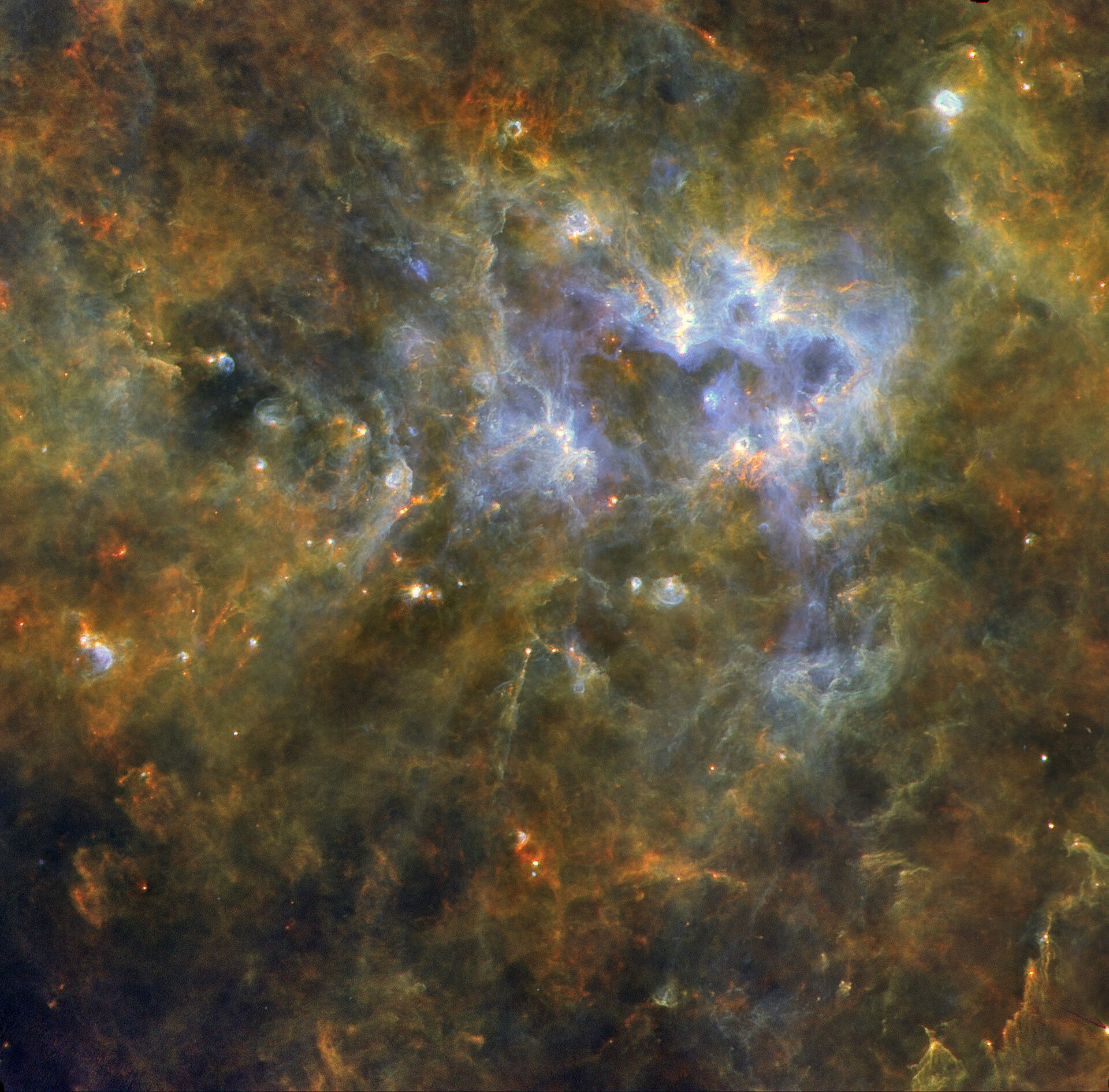
Hidden secrets of a massive star-formation region
Thank you for liking
You have already liked this page, you can only like it once!
Stellar nurseries are cloudy and dusty places that shine brightly in infrared light. The G305 star-forming complex is no exception. It features a number of bright, intricate gas clouds heated by infant stars in their midst. In this spectacular image by ESA’s Herschel space observatory, these star-forming hotspots stand out in a blue tone that contrasts with the red-brownish colour of cooler regions.
While there are several star-formation sites dotted throughout this scene, the most striking ones surround the dark, heart-shaped area in the top right of the image. Hidden at the centre of the dark region lie the massive star WR48a and its two neighbours, stellar clusters Danks 1 and 2. All three play an important role in triggering the formation of new stars, even if they themselves are relatively young objects no older than a few million years (for comparison, the Sun is around 4.6 billion years old).
Strong winds and radiation from WR48a and the high-mass stars in the two clusters have pushed away the gas remnants from the cloud where they originated. The swept-away gas, gathered together at the edge of the heart-shaped bubble, is now forming new stars.
Using Herschel, astronomers have identified 16 sites where high-mass stars are forming in this stellar nursery. The region is one of the brightest and most plentiful star-forming complexes in the Milky Way, and an ideal ground to observe and study massive stars at different stages of formation and evolution.
The G305 complex is about 12 000 light-years away and gets its name from its location at around 305º longitude in the plane of our Galaxy. In the night sky, it appears near the Coalsack Nebula, a large interstellar cloud of dust visible to the naked eye and located in the constellation of Crux, the Southern Cross. A very prominent dark nebula, Coalsack shows up in the southern skies as a black patch against the bright, starry backdrop of the Milky Way.
This image, obtained as part of Hi-GAL – the Herschel infrared Galactic Plane Survey, combines observations at three different wavelengths: 70 microns (blue), 160 microns (green) and 250 microns (red).
Launched in 2009, Herschel operated for four years observing at far infrared and submillimetre wavelengths. This spectral range allowed it to observe the glow of dust in gas clouds where stars are born to investigate this process and observe their early evolution.
-
CREDIT
ESA/Herschel/PACS, SPIRE/Hi-GAL Project. Acknowledgement: UNIMAP / L. Piazzo, La Sapienza – Università di Roma; E. Schisano / G. Li Causi, IAPS/INAF, Italy -
LICENCE
ESA Standard Licence
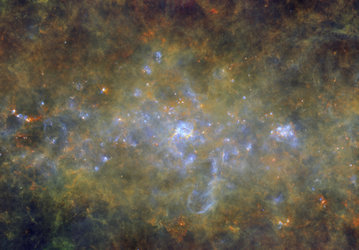
Intense star formation in the Westerhout 43 region
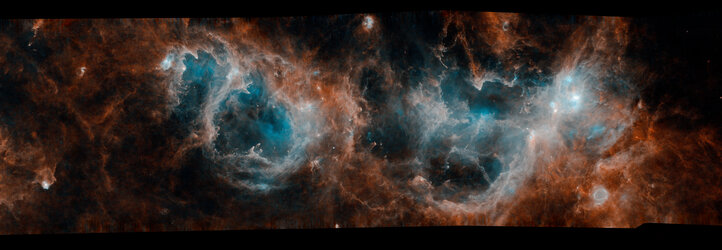
Herschel’s view of new stars and molecular clouds
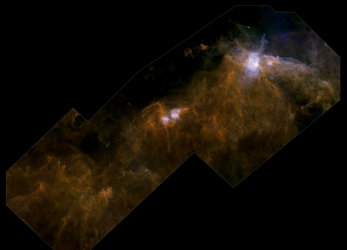
Herschel’s view of a molecular cloud
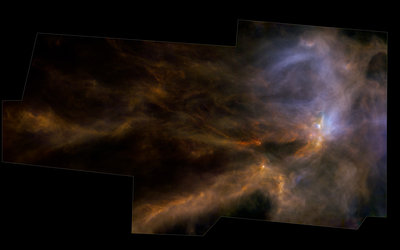
Rho Ophiuchi star-forming region
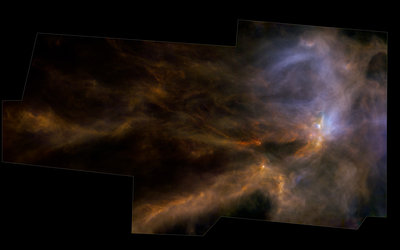














 Germany
Germany
 Austria
Austria
 Belgium
Belgium
 Denmark
Denmark
 Spain
Spain
 Estonia
Estonia
 Finland
Finland
 France
France
 Greece
Greece
 Hungary
Hungary
 Ireland
Ireland
 Italy
Italy
 Luxembourg
Luxembourg
 Norway
Norway
 The Netherlands
The Netherlands
 Poland
Poland
 Portugal
Portugal
 Czechia
Czechia
 Romania
Romania
 United Kingdom
United Kingdom
 Slovenia
Slovenia
 Sweden
Sweden
 Switzerland
Switzerland


























